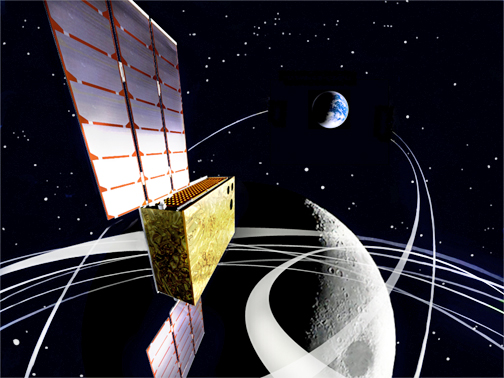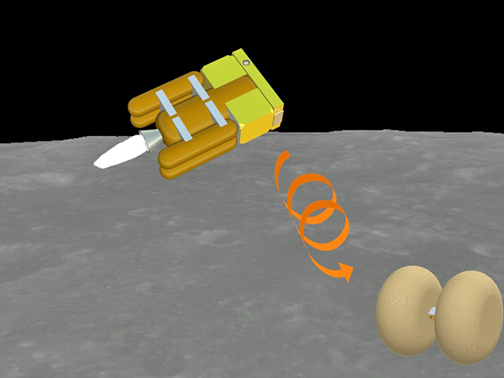
NASA’s new Space Launch System (SLS) will launch America into a new era of exploration to destinations beyond Earth’s orbit.
On its first flight, NASA will demonstrate the rocket’s heavy-lift capability and send an uncrewed Orion spacecraft into deep space. The agency will also take advantage of additional available mass and space to provide the rare opportunity to send more than a dozen small satellites (cubesats) to conduct experiments beyond LEO. In addition to the 10 cubesats announced earlier this year, the agency will be sending three from international partners.
“The first SLS launch presents a great opportunity to collaborate with our international partners by providing rides for cubesats that can pursue independent science and technology missions while supporting our mutual goals for human exploration in deep space,” said Steve Creech, acting manager of the Spacecraft and Payload Integration and Evolution Office, which handles integration of the secondary payloads at NASA’s Marshall Space Flight Center in Huntsville, Alabama, where SLS is managed.
These small satellites are designed to be efficient and versatile—no heavier than 30 pounds (14 kilograms), they are each about the size of a boot box and do not require any extra power from the rocket to function. The science and technology experiments enabled by these small satellites may enhance our understanding of the deep space environment, expand our knowledge of the moon, and demonstrate technology that could open up possibilities for future missions.

EQUULEUS (EQUilibriUm Lunar-Earth point 6U Spacecraft) will measure the distribution of plasma that surrounds the Earth to help scientists understand the radiation environment in the region of space around Earth. It will also demonstrate low-energy trajectory control techniques, such as multiple lunar flybys, within the Earth-Moon region.
Image is courtesy of JAXA/University of Tokyo
For the first SLS flight, the Japan Aerospace Exploration Agency (JAXA) and the University of Tokyo will jointly create and provide two cubesats, EQUULEUS (EQUilibriUm Lunar-Earth point 6U Spacecraft) and OMOTENASHI (Outstanding MOon exploration TEchnologies demonstrated by NAno Semi-Hard Impactor). EQUULEUS will help scientists understand the radiation environment in the region of space around Earth by imaging Earth’s plasmasphere and measuring the distribution of plasma that surrounds the planet. This opportunity may provide important insight for protecting both humans and electronics from radiation damage during long space journeys. It will also demonstrate low-energy trajectory control techniques, such as multiple lunar flybys, within the Earth-Moon region.

OMOTENASHI (Outstanding MOon exploration TEchnologies demonstrated by NAno Semi-Hard Impactor) demonstrate the technology for low-cost and very small spacecraft to land on the lunar surface. The cubesat will also take measurements of the radiation environment near the moon as well as on the lunar surface.
Artistic rendition is courtesy of JAXA/University of Tokyo.
JAXA also will use the OMOTENASHI to demonstrate the technology for low-cost and very small spacecraft to explore the lunar surface. This technology could open up new possibilities for future missions to inexpensively investigate the surface of the moon. The cubesat will also take measurements of the radiation environment near the moon as well as on the lunar surface.
“It is an exciting opportunity to go to the region of space near the moon with the Orion spacecraft on the historic first flight of SLS. In the near future, industry, academia, and even individuals will be able to, and should, easily participate in space exploration. To realize such a world, small and low cost spacecraft will be indispensable,” said Dr. Hashimoto, Professor of JAXA who leads the JAXA two CubeSats development. “JAXA proposed two exploration CubeSats, using Japanese advanced technologies for small spacecraft and collaborating with the University of Tokyo. Considering the mass and size limitations, it is a big challenge, but it will be a valuable first step to the new era.”

ArgoMoon will demonstrate the ability to perform operations in close proximity of the ICPS. It will also record images of the ICPS for historical documentation and to provide valuable mission data on the deployment of other cubesats. Additionally, this cubesat will test optical communication capabilities between the cubesat and Earth.
Image is courtesy of Argotec.
The Italian company Argotec is building the ArgoMoon CubeSat under the Italian Space Agency (ASI) internal review and approval process. ArgoMoon will demonstrate the ability to perform operations in close proximity of the Interim Cryogenic Propulsion Stage (ICPS), which will send Orion onto its lunar trajectory. It should also record images of the ICPS for historical documentation and to provide valuable mission data on the deployment of other cubesats. Additionally, this cubesat should test optical communication capabilities between the cubesat and Earth. The ArgoMoon cubesat proposal was put forth by the European Space Agency (ESA) in coordination with its member state, Italy.
“ASI is excited to share in this endeavor through the involvement of an Italian cubesat and to test such technology in a deep space environment, which is a first for this class of satellite,” said Arturo De Lillis, Argomoon program manager.
“This could be the first European cubesat to leave Earth orbit and we are looking forward to it capturing historic images of the first Orion mission,” said David Parker, ESA Director of Human Spaceflight and Robotic Exploration.
All the cubesats will ride to space inside the Orion Stage Adapter, which sits between the ICPS and Orion. The cubesats will be deployed following Orion separation from the upper stage and once Orion is a safe distance away.
SLS will have the payload capacity needed to carry crew and cargo for deep space exploration missions, including the journey to Mars. These small satellites are essentially piggybacking on the SLS flight and gaining an affordable opportunity to reach deep space destinations. Currently, most launch opportunities for cubesats are limited to LEO, the destination of the majority of today’s rockets. Although they may come in small packages, the science and technology investigations enabled by these cubesats will help play a role in paving the way for future human exploration in deep space, including the journey to Mars.
nasa.gov/exploration/systems/sls/index.html
Story edited by Jennifer Harbaugh, NASA.


To assist in acquiring the knowledge and expertise to enter and/or continue the acquisition of technology and product to become a successful smallsat actor, Satnews Publishers is delighted to announce that the SmallSat Symposium workshops will be held on February 6 and the conference will be conducted from February 7 to February 8, 2017, at the Computer History Museum, which is located at 1401 North Shoreline Boulevard in Mountain View, California.
A veritable "Who's Who" of subject-matter experts have already committed to presentations during this impact-filled symposium:

